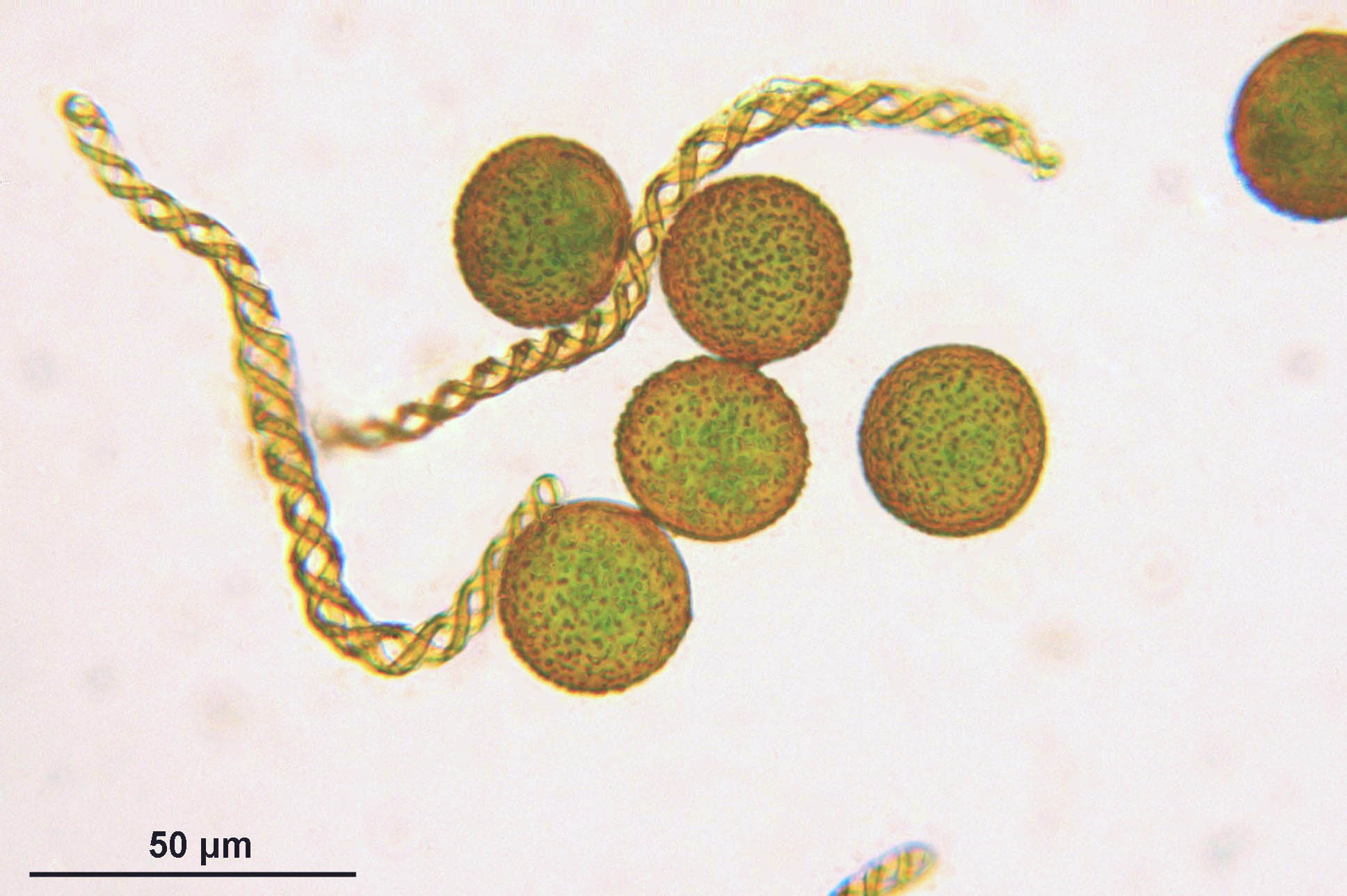Elater Pinguis on:
[Wikipedia]
[Google]
[Amazon]
An elater is a cell (or structure attached to a cell) that is hygroscopic, and therefore will change shape in response to changes in moisture in the

environment
Environment most often refers to:
__NOTOC__
* Natural environment, all living and non-living things occurring naturally
* Biophysical environment, the physical and biological factors along with their chemical interactions that affect an organism or ...
. Elaters come in a variety of forms, but are always associated with plant spore
In biology, a spore is a unit of sexual or asexual reproduction that may be adapted for dispersal and for survival, often for extended periods of time, in unfavourable conditions. Spores form part of the life cycles of many plants, algae, f ...
s. In many plants that do not have seeds, they function in dispersing the spores to a new location. Mosses
Mosses are small, non-vascular flowerless plants in the taxonomic division Bryophyta (, ) ''sensu stricto''. Bryophyta (''sensu lato'', Schimp. 1879) may also refer to the parent group bryophytes, which comprise liverworts, mosses, and horn ...
do not have elaters, but peristomes which change shape with changes in humidity or moisture to allow for a gradual release of spores.
Horsetail elaters
In the horsetails, elaters are four ribbon-like appendages attached to the spores. These appendages develop from an outer spiral layer of the spore wall. At maturity, the four strips peel away from the inner wall, except at a single point on the spore where all four strips are attached. Under moist conditions, the elaters curl tightly around the spore. The wet spores tend to stick to each other and to nearby surfaces because ofsurface tension
Surface tension is the tendency of liquid surfaces at rest to shrink into the minimum surface area possible. Surface tension is what allows objects with a higher density than water such as razor blades and insects (e.g. water striders) to f ...
. When conditions are dry, the spores no longer stick to each other and are more easily dispersed. At that time, the elaters uncoil to extend out from the spore and will catch air currents. The fact that they are extended only when conditions are dry means that successful spore dispersal is more likely.
Liverwort elaters
In theliverworts
The Marchantiophyta () are a division of non-vascular land plants commonly referred to as hepatics or liverworts. Like mosses and hornworts, they have a gametophyte-dominant life cycle, in which cells of the plant carry only a single set of ge ...
also known as hepaticopsida xample ''Riccia'',''Marchantia''
Gavin Harris, better known as Xample, is a British drum and bass producer and DJ, who originates from Bristol, England. He has been releasing records since 2003.
In June 2007, he scored a number 1 on the UK Dance Chart with his track " Lowdown ...
elaters are cells that develop in the sporophyte
A sporophyte () is the diploid multicellular stage in the life cycle of a plant or alga which produces asexual spores. This stage alternates with a multicellular haploid gametophyte phase.
Life cycle
The sporophyte develops from the zygote pr ...
alongside the spore
In biology, a spore is a unit of sexual or asexual reproduction that may be adapted for dispersal and for survival, often for extended periods of time, in unfavourable conditions. Spores form part of the life cycles of many plants, algae, f ...
s. They are complete cells, usually with helical thickenings at maturity that respond to moisture content.
In most liverworts, the elaters are unattached, but in some leafy species (such as ''Frullania
''Frullania'' is the only genus of liverworts in family Frullaniaceae. It contains the following species:
A
*''Frullania aculeata'' Taylor, 1846
*''Frullania acutata'' Caspary, 1887
*''Frullania acutiloba'' Gerola, 1947
*'' Frullania akiyama ...
'') a few elaters will remain attached to the inside of the sporangium
A sporangium (; from Late Latin, ) is an enclosure in which spores are formed. It can be composed of a single cell or can be multicellular. Virtually all plants, fungi, and many other lineages form sporangia at some point in their life cy ...
(spore capsule).
Hornwort pseudo-elaters
In thehornwort
Hornworts are a group of non-vascular Embryophytes (land plants) constituting the division Anthocerotophyta (). The common name refers to the elongated horn-like structure, which is the sporophyte. As in mosses and liverworts, hornworts have a ...
s, elaters are branched clusters of cells that develop in the sporophyte
A sporophyte () is the diploid multicellular stage in the life cycle of a plant or alga which produces asexual spores. This stage alternates with a multicellular haploid gametophyte phase.
Life cycle
The sporophyte develops from the zygote pr ...
alongside the spore
In biology, a spore is a unit of sexual or asexual reproduction that may be adapted for dispersal and for survival, often for extended periods of time, in unfavourable conditions. Spores form part of the life cycles of many plants, algae, f ...
s. They are complete cells, usually without helical thickenings (except in the Dendrocerotaceae
The Dendrocerotaceae is the only family of hornwort
Hornworts are a group of non-vascular Embryophytes (land plants) constituting the division Anthocerotophyta (). The common name refers to the elongated horn-like structure, which is the spor ...
).
References
* Bold, Harold C., Alexopoulos, Constantine J., & Delevoryas, Theodore. (1987). ''Morphology of Plants and Fungi'', (5th ed.). New York: Harper & Row. . * Campbell, Douglas Houghton. (1918). ''The Structure and Development of Mosses and Ferns'', (3rd ed.). New York: The Macmillan Company. * Kenrick, Paul & Crane, Peter R. (1997). ''The Origin and Early Diversification of Land Plants: A Cladistic Study''. Washington, D. C.: Smithsonian Institution Press. {{ISBN, 1-56098-730-8. * Smith, Gilbert M. (1938). ''Cryptogamic Botany, Volume II: Bryophytes and Pteridophytes''. New York: McGraw-Hill Book Company. Plant anatomy